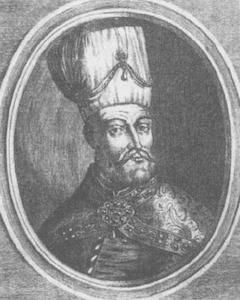On this date in 1682, the boyar Ivan Andreyevich Khovansky went from being the power behind the throne to one of the skulls under it.
 A veteran military commander, Khovansky (English Wikipedia entry | Russian) became a key figure in the months after the death of Tsar Feodor III of Russia. This perilous political moment left the throne in the hands of two underage half-brothers overseen by a female regent.
A veteran military commander, Khovansky (English Wikipedia entry | Russian) became a key figure in the months after the death of Tsar Feodor III of Russia. This perilous political moment left the throne in the hands of two underage half-brothers overseen by a female regent.
With benefit of hindsight we know that 10-year-old (in 1682) Peter will emerge from this troika to become the mighty Tsar Peter the Great. In 1682, it was anybody’s guess whether any of these dubious prospective autocrats might survive at all.
Peter in particular had cause to fear for his life in May 1682 when the Streltsy, a hereditary guard of Moscow musketeers, bloodily rebelled in favor of his co-heir’s privileges and against his own, rampaging through the Kremlin murdering princes in Peter’s circle. And at the head of these furies stood Khovansky.
Many years later, Peter would revenge himself upon the Streltsy for this horror but in the moment it carried the day, incidentally also carrying Khovansky to a preeminent position in the state.
But he was pitted almost immediately against his erstwhile patron and ally, the regent Sophia Alekseyevna.
Even though the Streltsy rebellion had been conducted on Sophia’s behalf, she could see as well as the next tsar the perils of embracing these latter-day praetorians‘ authority to remake the government by force … and the Streltsy made sure to remind her of it almost immediately when the “Old Believer” movement that predominated among its ranks started raising complaints about Sophia’s religious accommodations.*
Fearing an overmighty nobleman at the head of a treasonable host — and Khovansky has been suspected by both his contemporaries and posterity of coveting the regency for himself — Sophia and the young co-tsars briefly fled Moscow “because we could not tolerate the many offences, unlawful and gross actions and violations committed by criminals and traitors.” Meanwhile she maneuvered adroitly to isolate him politically and had the boyar Duma vote his attainder.
His fate was sealed by the discovery of an anonymous (probably fabricated) letter of denunciation. On 17 September, her own name day, Sophia succeeded in luring Ivan Khovansky and his son Ivan to the royal summer residence at Vozdvizhenskoe outside Moscow. The charges against them centred on their ‘evil designs upon the health and authority of the great sovereigns’ which involved no less than plotting to use the strel’tsy to kill the tsars, Tsaritsa Natalia, Sophia and the patriarch, then to raise rebellion all over Moscow and snatch the throne. The lesser charges included association with ‘accursed schismatics’, embezzlement, dereliction of military duty, and insulting the boyars. The charges were full of inconsistencies and illogicalities, but their sheer weight sealed the Khovanskys’ fate and Prince Ivan and his son were beheaded on the spot … The strel’tsy were forced to swear an oath of loyalty based on a set of conditions, the final clause of which threatened death to anyone who ‘speaks approvingly of the deeds of late, or boasts of committing murder or makes up phrases inciting rebellion as before, or stirs up people to commit criminal acts.’ (Source)
He’s the subject of the Mussorgsky opera Khovanshchina.
* Old Believers wanted a rollback of religious reforms decreed in recent years; Sophia said no dice. Once Peter the Great took over, Sophia and Old Believers alike would end up in the same boat.
On this day..
- 1943: The officers of the 13th Waffen Mountain Division of the SS Handschar, during the Villefranche-de-Rouergue mutiny
- 1915: Augusto Alfredo Roggen, World War I spy
- 1524: Caspar Tauber, Protestant protomartyr of Vienna
- 1858: Preston Turley, drunkard preacher
- 1811: Anna Maria Zwanziger, "once beautiful, exceedingly beautiful"
- 1971: Victor Apaza Quispe, Arequipa folk saint
- 1814: Vicente Salias, Venezuelan national anthem author
- 1895: The Vegetarian perpetrators of the Kucheng Massacre
- 1912: Bertram Spencer
- 1773: David Reynolds, colonial counterfeiter
- 1961: Adnan Menderes
- 1938: Nikolai Kondratiev, purged economist
